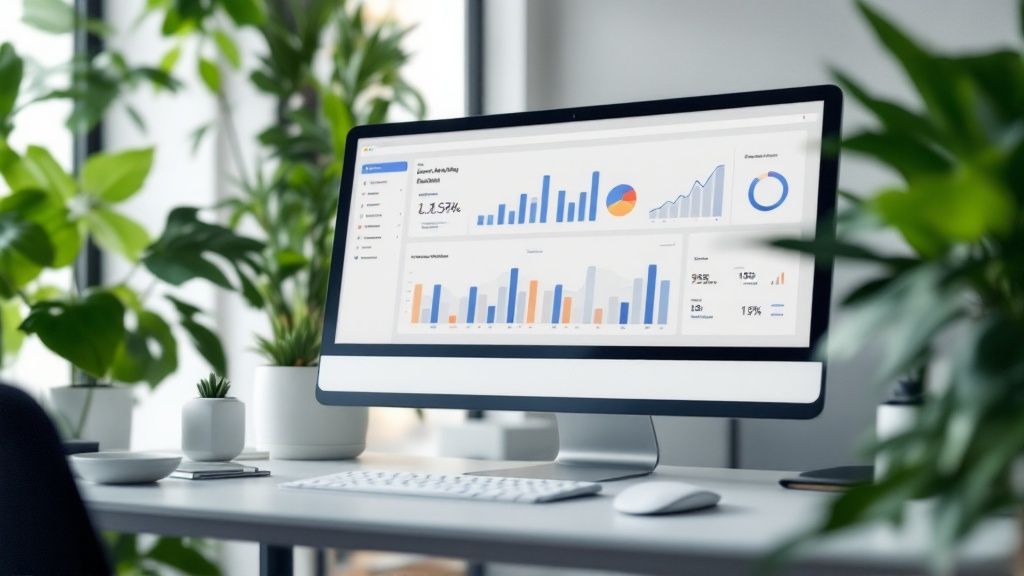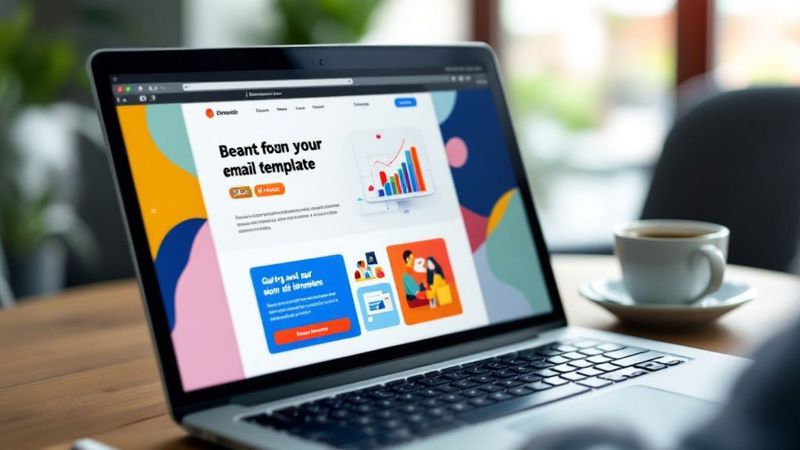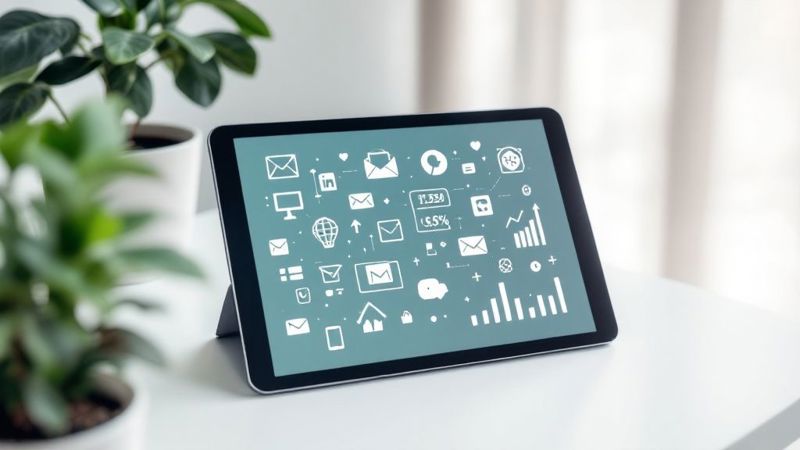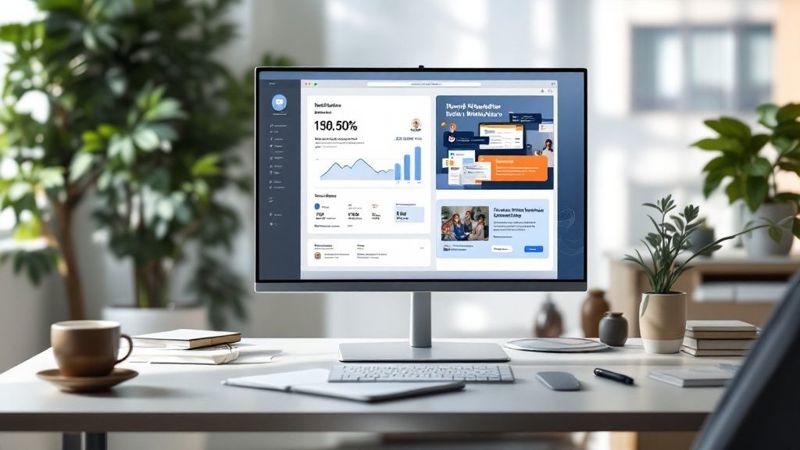Why Visuals Are the Hidden Driver of Email Success

Email marketing success depends heavily on catching your readers' eye. While great writing matters, it's the visual elements that often make the biggest impact. Pictures and graphics tell your story instantly, making complex ideas simple to grasp and helping forge emotional connections with your audience.
Think about your own email habits - do you linger longer on messages with appealing visuals compared to walls of text? Smart use of images breaks up content into digestible chunks while building your brand's visual identity. When people see consistent imagery across your emails, website, and social media, they begin to recognize and trust your brand more deeply.
The numbers back this up convincingly. Research shows emails with graphics see a 7.33% boost in open rates and 3.2% higher click-through rates versus plain text emails. These findings come from DesignRush's comprehensive email marketing study. The data proves that well-chosen visuals drive real engagement.
The Psychology of Visual Appeal in Email
Our brains are wired for visual processing - we understand images 60,000 times faster than written words. This explains why a strong image can communicate your message almost instantly. Pictures also tap directly into emotions in ways that text alone rarely achieves, creating deeper connections that inspire action.
Best Practices for Using Images in Email Marketing
Getting results with email images requires a thoughtful approach. Here's what works:
- Relevance: Pick images that strengthen your message and speak to your specific audience
- Quality: Use crisp, professional images optimized for quick loading
- Balance: Find the sweet spot between visuals and text for easy reading
- Accessibility: Include clear alt text so all subscribers can understand your content
- Testing: Try different image types and placements to see what your audience prefers
When you follow these guidelines, your email images become powerful tools that boost engagement and drive real business results.
Building Authentic Visual Connections That Convert
People can easily spot and dismiss overly polished marketing content these days. Audiences want real, genuine connections in their inbox, not perfectly curated images that feel fake or manufactured. Smart brands are finding success by moving away from overly edited visuals and embracing more natural, authentic content.
The Power of Raw and Unfiltered Imagery
With AI-generated content becoming more common, people are actively seeking real human connections. Perfect, heavily edited marketing materials often fail to create that emotional bond. Using candid photos of real people and actual experiences helps build trust naturally. Many brands are now skipping stock photos in favor of authentic lifestyle imagery that shows their true identity.
Some companies are already seeing great results with this approach. For example, Patagonia and GiftShop include unedited photos and behind-the-scenes video clips in their email newsletters to build authentic connections with customers. Check out more email design trends here. This strategy works because it aligns with what modern consumers want - honest communication from brands they can trust.
Balancing Authenticity with Brand Guidelines
Being authentic doesn't mean sacrificing quality. The key is finding the right balance between natural, unfiltered content and maintaining your professional brand standards. Your email visuals should feel genuine while still fitting your overall brand identity and message.
Sourcing and Creating Authentic Visual Content
There are several effective ways to create authentic visual content:
- Feature user-generated photos and videos showing real customers using your products
- Share candid behind-the-scenes glimpses into your company culture and team
- Work with genuine influencers who truly connect with your target audience
- Capture natural, in-the-moment photos rather than overly staged shots
Measuring the Impact of Authentic Visuals
Success comes down to the numbers. Track important metrics like:
- Open rates to measure initial engagement
- Click-through rates to gauge content relevance
- Conversion rates to determine bottom-line impact
By monitoring these key performance indicators, you can refine your visual strategy for maximum engagement and sales. Regular analysis helps ensure your authentic content delivers real business results.
Creating Personal Connections Through Visual Email Content

Email marketing needs a personal touch to succeed. Generic mass emails often get ignored, but messages crafted for individual subscribers can create real connections. The key is going beyond just adding someone's name - it's about creating meaningful visual experiences that resonate.
Smart Image Personalization That Works
Adding personalized images to emails delivers measurable results. When Virgin customized their email images using subscriber data, they saw a 29% jump in click-through rates. This kind of success comes from thoughtfully incorporating personal details like names, locations, and product recommendations based on shopping history. Learn more about email performance metrics at OptinMonster's Email Marketing Stats.
Using Behavior and Predictions to Guide Visual Content
Behavior-based emails work well for re-engaging subscribers. For example, if someone leaves items in their cart, send a follow-up featuring those specific products along with a custom discount. Smart content prediction takes this further by analyzing past purchases and browsing to show products each person is most likely to want.
Read also: How can personalized images increase email engagement?
Making it Work: Groups, Testing and Measurement
Start by creating focused audience segments based on shared traits. A clothing store might group subscribers by style preferences, gender and age to show relevant product images. But great visuals are just the start - you need to measure what works. Track clicks, sales, and other key metrics to see which image strategies connect best with your audience.
Growing Your Personalization Strategy
Begin with simple personalization, then expand across your email program as you learn what works. The right email marketing tools make it possible to automatically create custom images for large subscriber lists. Success comes from combining smart technology with a clear understanding of what your audience wants to see. This helps you build email campaigns that spark real engagement and drive more sales.
Mastering the Art of Visual-Text Balance

Creating effective email campaigns requires careful attention to how you mix images and text. When you use too many images, spam filters may flag your emails. Too much text can make readers lose interest. Getting this balance right affects whether your emails reach inboxes and how well they perform.
Finding the Right Ratio for Your Emails
Think of your email like a recipe - you need just the right amount of each ingredient. Product launch emails often work better with more images to show off new items. Industry newsletters typically need more text to share detailed insights. Want to learn more? Check out how to master email image customization.
Studies show that 66% of email readers prefer messages with strong visual elements, finding them more engaging and easier to understand. But going overboard with images can hurt deliverability. The key is finding what works for your specific audience. For more tips, see best practices for email images.
Testing and Optimizing Image-to-Text Ratio
Start with a 60% text to 40% images mix as your baseline. This helps you avoid spam filters while keeping readers engaged. But remember - there's no perfect formula that works for everyone. The best ratio depends on your readers, your industry, and what you want to achieve with each email.
Tailoring the Balance to Different Email Types
Here's what works well for different types of emails:
- Promotional Emails: Use more images to showcase your products and offers clearly
- Newsletters: Mix text and images evenly to keep readers interested
- Nurture Sequences: Focus on helpful content with strategic use of images
- Transactional Emails: Keep it simple with mostly text and minimal images for branding
Pay attention to how your audience responds to different image-text combinations. Track your results and adjust based on what gets the best engagement. This helps you create emails that look great, drive action, and consistently make it to the inbox.
Implementing Technical Excellence in Email Imagery
Email marketing images need solid technical foundations to work effectively. Even beautiful visuals can fail if they don't load quickly or display properly across devices. Let's look at practical ways to make your email images perform at their best.
Image Optimization for Email: Size and Format
Start with proper image optimization. Heavy image files create slow loading emails that frustrate recipients and hurt engagement. The solution is smart image compression - tools like TinyPNG or ShortPixel can shrink file sizes while keeping image quality intact.
Pick the right image format for each use case. Use JPEGs for photographs since they compress well and work everywhere. Choose PNGs for graphics with text or sharp edges since they handle transparency better. Avoid using GIFs for large images as they create bigger files.
Responsive Design for Email Images
Most people check email on mobile devices, so your images need to look good on any screen size. Responsive design helps images scale smoothly across different displays without awkward cropping. Set image widths using percentages in your HTML code for better adaptability.
Accessibility Considerations for Email Images
Make your emails work for everyone by prioritizing accessibility. Add clear alt text to every image so screen readers can describe them to visually impaired subscribers. Good alt text also helps when email clients block images by default.
Ensuring Reliable Image Delivery
Fast, consistent image loading is key. Using a Content Delivery Network (CDN) speeds up delivery by serving images from servers near your subscribers. This especially helps when reaching audiences across different regions. Learn more in our guide on The Power of Dynamic Email Images.
Host images externally instead of embedding them directly in your HTML. This keeps email file sizes smaller and improves deliverability rates.
Troubleshooting Common Image Issues in Email
Watch out for these common image problems:
- Broken Images: Verify all image URLs work and hosting is accessible
- Blocked Images: Ask subscribers to whitelist your sending address since some email clients block images
- Display Problems: Test thoroughly across email clients and devices to catch and fix rendering issues
Master these technical aspects to ensure your email images make the impact you want. Well-optimized, accessible images that load quickly will strengthen your brand and drive better results.
Measuring and Optimizing Visual Performance

Getting the most from your email marketing images requires careful tracking and fine-tuning. While eye-catching visuals are important, they need to actually drive opens, clicks and conversions. Let's look at practical ways to measure what's working and improve your results.
Quantifying Visual Impact in Emails
To know if your images are effective, you need to track key performance metrics:
- Click-Through Rate (CTR): What percentage of recipients click your email links?
- Conversion Rate: How many take your desired action after clicking?
- Engagement: Are people forwarding and sharing your emails?
These numbers tell you which images grab attention and inspire action, helping you replicate successful approaches.
Implementing A/B Testing for Images
A/B testing lets you compare different image versions to find winners. Here's a simple process:
- Pick What to Test: Try different sizes, placements, or designs
- Split Your List: Randomly divide subscribers into test groups
- Check the Results: Compare CTRs and conversions between versions
This methodical testing reveals which visual elements connect best with your audience.
Tools and Techniques for Image Evaluation
Several helpful tools can measure image performance:
- Heatmaps: Show exactly where subscribers look and click in your emails
- Analytics: Track what happens after clicks using tools like Google Analytics
These insights help you make smart choices about your visual content.
Using Insights to Refine Your Strategy
Put your data to work by steadily improving your visual approach. Test new image types, adjust placement based on heatmaps, and stay current with what your audience responds to. Small tweaks based on real results add up to better engagement over time.
Smart measurement and optimization of email images leads directly to better results. To take your visual content further, consider using OKZest to create personalized images that speak directly to each subscriber. Check out how OKZest can enhance your email campaigns today!